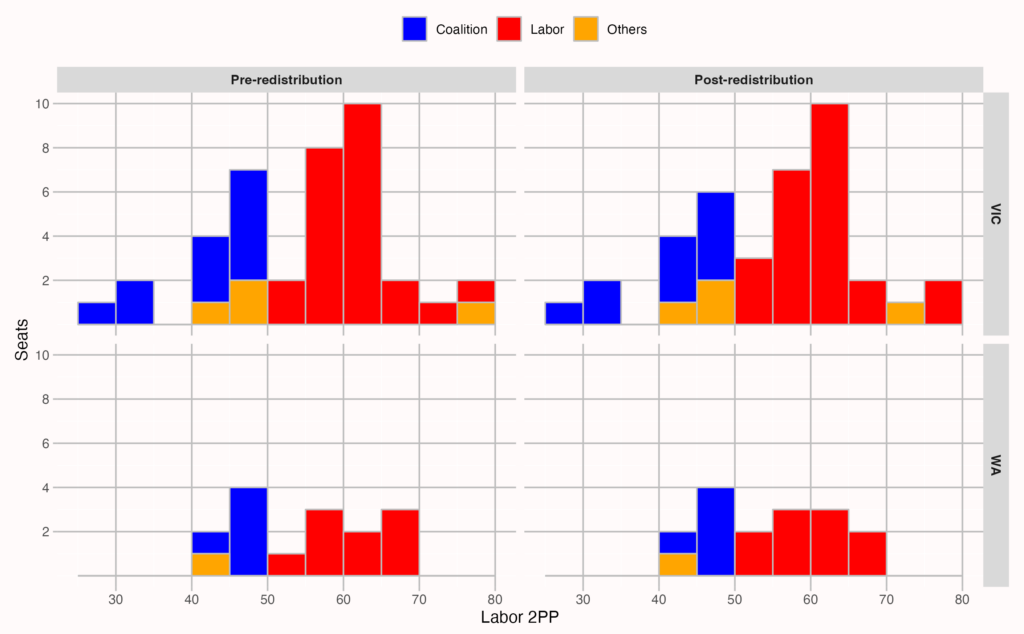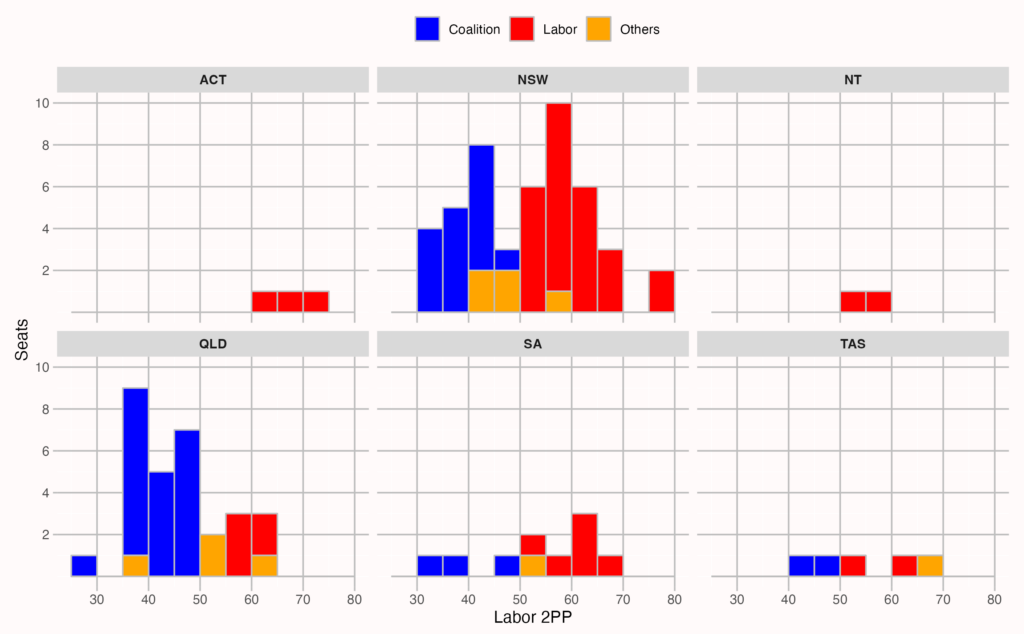Last Friday’s analysis tended to focus on two scales: either the level of the individual seat, or looking at the party totals across each state.
At the federal redistributions in Victoria and Western Australia, three seats had a change in party status: Bullwinkel was created as notional Labor seat, Higgins was abolished and Menzies flipped from Liberal to Labor.
But sometimes it’s not just about which seats may have switched from one side to the other, but how much a seat’s margin has changed.
It’s also worth understanding how much these seat changes cancel each other out, or change the overall shape of the pendulum.
A majority of the two-party-preferred vote does not necessarily give a party (or a broader side of politics) a majority of seats, but examining the distribution of margins can give an insight into who has a more efficient distribution of votes.
This type of chart has been described in the past as a constituency population distribution (CPD). In an earlier era of political analysis, there was a lot of attention paid to understanding the likely seat counts that would be expected to flip with a particular swing, and whether there is any particular electoral bias that favours one major party over the other when they have a tied vote. Thus a pendulum can theoretically play a predictive role in knowing how a particular change in vote would translate into seat counts.
I’m not interested in trying to use this analysis to predict how a particular vote would translate into seats, but it is still useful to understand how much the redistribution has favoured one party or another, and therefore who has a more efficiently-distributed vote.
This chart is simple, it just shows the two-party-preferred margin for each seat, grouped in 5% buckets. Seats are coloured by whether they were won by Labor, Coalition or someone else. Of course there are seats that don’t go to one of the major parties, but need to be included to have a complete dataset.

There were seven seats with a Coalition two-party-preferred vote of 50-55% in Victoria in 2022. That included the two teal seats in Melbourne. That number has been cut by one on the draft boundaries, which reflects the flipping of Menzies from Liberal to Labor. This can also be seen by the increase in the number of Labor seats with a 50-55% 2PP.
Labor has a larger number of seats held by margins of 55-65%, but that category has been reduced by one. It’s interesting to note that Higgins actually had a margin of 2%, but the changing in other seat margins has meant that Labor has lost one seat on a greater margin while holding more seats on a slimmer margin.
So when you look at the whole chart, there is one more Labor seat on a slim margin, one less Liberal seat on a slim margin, and one less Labor seat in the 55-60% range.
Labor polled 54.8% of the 2PP in Victoria in 2022. Prior to the redistribution, 16 out of 39 seats had a Labor 2PP of less than the statewide average. That number on the draft boundaries is 16 out of 38. Either way, that’s a substantial bias in favour of the ALP, but it’s one less after the redrawing. Once you adjust for Labor’s 4.8% statewide margin, the Coalition has more very safe seats. The Coalition has seven seats held by 55.2% or more, while Labor has just five seats held by 64.8% or more.
The distribution of seats in Western Australia is much more even – more like a rectangle than a bell curve. And it also doesn’t show the same bias. Labor polled 55% of the 2PP in Western Australia, and won eight out of fifteen seats by more than 55%.
The redistribution has added one more Labor seat by a margin of under 55%. That means that exactly half the seats have a margin on the Labor side of the statewide average, and half on the Liberal side (admittedly this includes independent Curtin).
That new Labor seat was Bullwinkel, but if there were to be a uniform swing back to a 50% 2PP, that seat would be left as a Liberal seat. While Labor will be pleased to have one more notional seat, the WA part of the pendulum now looks a bit more balanced towards the right.
Likewise in Victoria – the Liberal Party has lost a notional seat, but the bias towards Labor on the pendulum is now slightly less than before. There were seven more seats with a higher Labor 2PP than the state compared to those with a lower 2PP prior to the redistribution, but on the proposal that number is just six.
This second chart shows the same histograms for the other six jurisdictions. The three smallest states don’t have much of interest, but NSW and Queensland are definitely interesting.

Twenty NSW seats gave the Coalition a majority of the 2PP, plus two Labor seats which were won by less than Labor’s 1.4% 2PP statewide majority. That’s 22 out of 47 seats, with 25 relatively Labor-leaning. That’s a slight bias towards Labor.
Only eight Queensland seats gave Labor a 2PP majority (three of them actually won by the Greens), but there’s five LNP seats won by less than the LNP’s statewide majority. That means 17 seats voted more favourably towards the LNP than the state, and 13 towards Labor. A slight bias towards the LNP.
There is no bias in South Australia, with three Liberal seats, as well as Mayo and Boothby, all polling a Labor 2PP less than the state. That’s five out of ten.




The next NSW redistribution will basically have to favour the Coalition with the Coalition almost certainly gaining at least one seat (Paterson) plus maybe others (Gilmore, etc).
Interestingly the 2016 redistribution flipped Paterson from a safe Liberal seat to a notional marginal Labor seat with Labor winning it easily in 2016 with an increased margin until Labor’s margin dropped by a fair amount in 2019 with their margin dropping again in 2022 (only slightly though). And now it looks like Paterson will become a notional marginal Liberal seat.
I think sometimes people get very caught up in seats changing hands at redistributions. At the end of the day if a seat goes from being 0.5% ALP to .5% LIB, that’s only a 1% difference and it isn’t all that often seats are decided on margins that small.
I think Chisholm is a good example. A lot more attention will be placed on Higgins and Menzies becoming notionally Labor, but a seat like Chisholm on its proposed boundaries would have been relatively safe for Liberals before the 2022 election. I don’t even think Labor would have won it in 2007 or 2010. But because it doesn’t change hands it gets a lot less attention.
Hi Ben, I think there’s a small error in your SA chart, with Mayo showing as a Labor seat rather than Others. Otherwise great analysis as always!
There was a 6% swing against labor in a recent poll so anything under this is at risk. So that gives the coalition Bullwinkle and tangey and possibly curtin. Sures up moore and canning and puts Cowan swan Pearce and hasluck into marginal status in my opinion and they could possibly make the rest back to marginal status if the have a good run but probably wouldn’t in those.
so predicitions for NSW this fridaY?
@Tavis – In Mayo in 2022, Labor won 51% of the 2PP against the Liberals. Rebekha Sharkie (incumbent) still won the seat with 62% of the 2CP.
Comments are closed.